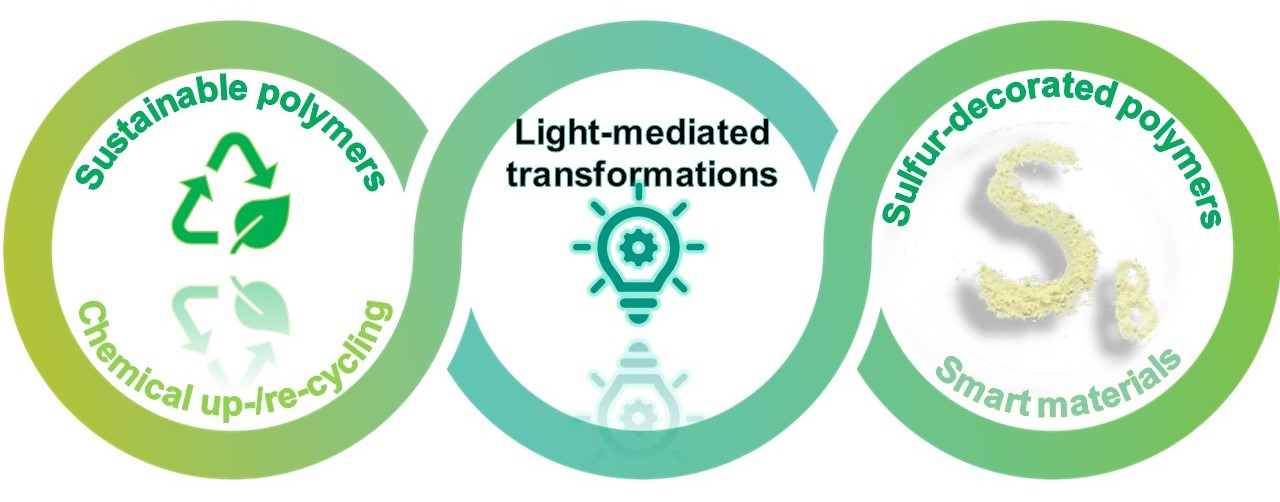Tailor-Made Functional Polymeric (circular) Materials
Tailor-Made Functional Polymeric (circular) Materials
Hatice Mutlu hatice.mutlu@uha.fr
Development of novel sulfur-decorated materials in line with the concept of circular chemistry

Efficient modification strategies
Hatice Mutlu, Janna Jeschke, Bercis Pektas
The controlled polymerization of the (re)active monomer is followed by the polymer analogue conversion in a second step, the actual modification step. In this way, new classes of functionalized block copolymers can be developed. In combination with controlled polymerization methods, we have succeeded in incorporating reactive groups at defined positions within a polymer chain. End-functionalized polymers are suitable for conjugation with biological macromolecules. Using orthogonal reactive groups, we were able to produce highly functionalized block copolymers by sequential reactions. Besides classical methods of ester-amine reactions, azide-alkyne cycloadditions, thiol-ene reactions, etc., we are currently focusing on multicomponent reactions for the modification of polymers. The use of efficient reactions for functionalization allows us to either work atom- economically or to reuse used auxiliaries accordingly. In recent studies, we build on efficient multi-component reactions for the modification and synthesis of functional polymers. But sequential reactions are also the subject of our research for this field.
Publications
E. Molle, H. Mutlu,* P. Theato,* Macromol. Rapid Commun. 2021, 42, 2100063
W. Xue, H. Mutlu, P. Theato,* Eur. Polym. J. 2020, 130, 109660
D. H. S. Ntoukam, H. Mutlu, P. Theato,* Eur. Polym. J. 2020, 122, 109319
J. T. Offenloch, H. Mutlu,* C. Barner‐Kowollik,* Macromolecules 2018, 51, 2682.
Synthesis of complex and functional (stimuli-responsive) macromolecules, surfaces and materials
Hatice Mutlu, Janna Jeschke, Bercis Pektas, Sandric Afonso
Recently, we have developed new polymer-forming reactions and novel conjugation chemistries which enable the design of hybrid materials with a particular focus on biomimetic synthetic molecules and dynamic photo-responsive nanostructures as synthetic proteins.[1] For instance, aiming to mimic the function of proteins, yet utilizing the synthetic ease of human‐ made polymers, a new class of fluorescent self-immolative nanostructures, which represents a technology platform for drug delivery was developed.[2] Alternatively, single-chain folded nanoparticles (SCNPs) that emit information about their folding state and constitute a critical step forward as reversibly addressable imaging agents were designed. we could also show that targeted manipulation of catalytic activity of the synthetic proteins (i.e., SCNPs) can be reversibly altered by light.
Publications
[1] a) L. D. Thai, T. R Guimaraes, L. C. Chambers, J. A. Kammerer, D. Golberg, H. Mutlu,* J. Am. Chem. Soc. 2023, 145, 14748 ; b) M. S. Akdemir, B. Huber, M. Simian, H. Mutlu,* P. Theato,* ACS Appl. Polym. Mater. 2023, 5, 6643 ; c) M. S. Akdemir, M. Simian, P. Theato,* H. Mutlu,* Macromol. Chem. Phys. 2023, 224, 2200371 ; d) S. Sheshachala, B. Huber, J. Schuetzke, R. Mikut, T. Scharnweber, C. M Domínguez,* H. Mutlu,* C. M Niemeyer,*Nanoscale Adv. 2023, 5, 3914 ; e) L. D. Thai, T. R Guimaraes, S. Spann, A. S Goldmann, D. Golberg, H. Mutlu,* C. Barner‐Kowollik,* Polym. Chem. 2022, 13, 5625 ; f) J. Hobich, B. Huber, P. Theato, H. Mutlu,* Macromol. Rapid Commun. 2021, 42, 2100118 ; g) J. T. Offenloch, S. Bastian, H. Mutlu,* C. Barner‐Kowollik,* ChemPhotoChem 2019, 3, 66 ; h) L. Greb,# H. Mutlu,# C. Barner-Kowollik,* J.-M. Lehn,*J. Am. Chem. Soc. 2016, 138, 1142 ; i) H. Mutlu, C. Barner-Kowollik,* Polym. Chem. 2016, 7, 2272.
[2] a) J. T. Offenloch, E. Blasco, S. Bastian, C. Barner-Kowollik,* H. Mutlu,*Polym. Chem. 2019, 10, 4513 ; b) T. Fischer, S. Spann, Q. An, B. Luy, M. Tstotsalas, J. P. Blinco, H. Mutlu,* C. Barner- Kowollik,* Chem. Sci. 2018, 9, 4696 ; c) T. K. Claus, J. Zhang, L. Martin, M. Hartlieb, H. Mutlu, S. Perrier, G. Delaittre, C. Barner-Kowollik,* Macromol. Rapid Commun. 2017, 38, 1700264 ; d) N. Wedler-Jasinski, T. Lueckerath, H. Mutlu, A. S. Goldmann, A. Walther, M. H. Stenzel, C. Barner-Kowollik,* Chem. Commun. 2017, 53, 157.
Self-reporting materials
Hatice Mutlu, Janna Jeschke, Sandric Afonso
Within our efforts in mimicking functions of natural materials, we were not limited only with the synthesis of dynamic light-responsive soft-matter materials with permanent or latent luminescence and fluorescence, we could also show that light is a powerful tool to monitor reactive oxygen species (ROS) in a self-reporting manner. Luminol has attracted scientific interest owing to its low cost and compatibility with a large number of analytes, yet the chemiluminescent (CL) emission generated during the oxidation of luminol is of relatively low intensity. Therefore, a guanidine-based superbase as an efficient CL booster was developed. In contrast to conventional base, organic superbases have allowed the synthesis of monomers for the implementation within multi-functionalized polymers and pave the way for the development of polymeric self-reporting CL-systems. Moreover, with the aim to reveal that self-reporting polymers has great potential in terms of technical materials applications (e.g., sulfur-based polymers) as well in the area of therapeutic delivery and imaging, high sulfur content polymers were synthesized that could be implemented as a platform material with specified functions (e.g., self-organization, adaptive self-sorting, molecular motion, replication and transcription amongst others) and potential application as protein biochips. Quite recently, in line with those research activities in the field of sulfur-based polymers, novel class of sulfur-nitrogen based polymers have been synthesized. Importantly, those polymers mimic -amino acid derivatives and thus attract attention by virtue of their potential antibacterial and antifungal activities.
Publications
a) H. Mutlu,*Polym. Chem. 2022, 13, 1648 ; E. Molle, H. Mutlu,* P. Theato,* Macromol. Rapid Commun. 2021, 42, 2100063 ;
b) C. M. Geiselhart, C. Barner-Kowollik,* H. Mutlu,*Polym. Chem. 2021, 12, 1732 ;
c) C. M. Geiselhart, H. Mutlu,* Macromol. Chem. Phys. 2021, 222, 2100057 ;
d) C. M. Geiselhart, H. Mutlu,* C. Barner-Kowollik,* Angew. Chem., Int. Ed. 2021, 60, 17290 ; M. E. Duarte, B. Huber, P. Theato, H. Mutlu,* Polym. Chem. 2020, 11, 241 ;
e) H. Mutlu,* C. W. Schmitt, N. Wedler-Jasinski, H. Woehlk, K. E. Fairfull-Smith, J. P. Blinco, C. Barner-Kowollik,*Polym. Chem. 2017, 8, 6199 ;
f) [C. M. Geiselhart, C. W. Schmitt, P. Jöckle, H. Mutlu,* C. Barner-Kowollik,* Sci. Rep. 2019, 9, 14519.
Chemical recycling via repurposing to either modified polymer, oligomer, or small molecules
Hatice Mutlu, Janna Jeschke
In the recent years we have seen sustainable approaches and technologies, commonly known as upcycling, e.g., to transform “potentially waste” commercial polymers into value-added materials and chemical feedstocks. For instance, we have transformed commercially available polybutadiene polymers to new higher-value materials, thus giving post-consumer polymers a new life, thereby extending their lifetime. Moreover, light was utilized as a popular choice as exogenous stimulus for chemical transformations of polyethylene derivatives. It is of critical importance to emphasize that light was used not only as trigger, but we have utilized it as read- out of chemically induced process. In fact, chemiluminescence (CL), i.e., light as direct output of a chemical reaction, entails several benefits ranging from high sensitivity to simultaneous real-time monitoring over a wide dynamic range without the need of sophisticated equipment. Thus, CL was used as a visible tool to read-out the cost-effective repurposing method with which was aimed to deliver new value-added polymers/oligomers.
Publications
[a) C. M. Geiselhart, W. Xue, C. Barner-Kowollik,* H. Mutlu,* Macromolecules 2021, 54, 1775;
b) C. M. Geiselhart, H. Mutlu,* P. Tzvetkova, C. Barner-Kowollik,*Polym. Chem. 2020, 11, 4213;
c) J. T. Offenloch, S. Norsic, H. Mutlu, M. Taam, O. Boyron, C. Boisson, F. D´Agosto, C. Barner-Kowollik,* Polym. Chem. 2018, 9, 3633;
d) H. Mutlu,* C. M. Geiselhart, C. Barner-Kowollik,* Mater. Horiz. 2018, 5, 162; c) J. Steinkoenig, M. M. Zieger, H. Mutlu,* C. Barner‐Kowollik,* Macromolecules 2017, 50, 5385;
e) J. T. Offenloch, J. Willenbacher, P. Tzvetkova, C. Heiler, H. Mutlu,* C. Barner‐ Kowollik,* Chem. Commun. 2017, 53, 775;
f) C. M. Geiselhart, J. T. Offenloch, H. Mutlu,* C. Barner‐Kowollik,* ACS Macro Lett. 2016, 5, 1146.
Harvesting landfill (and domestic) waste towards functional hybrid materials for diverse applications
Hatice Mutlu, Sandric Afonso
Landfill waste : Petroleum refineries as purposeful human activities produce more by-products, i.e., elemental sulfur (S8) than the market can absorb, whereas this element constitutes only about 0.052 wt % of the Earth’s crust. As a consequence, large « native » deposits of yellow non-toxic S8 (> 7 million tons annually) have piled up near remote operations as landfill waste, despite more than 200 years of sulfur research. Surprisingly, the chemical transformations of S8 and sulfur- rich compounds are still full of « white spots ». Thus, we have designed novel (polymeric) materials that may become the long-term outlet for the surplus S8 and may replace materials based on fossil carbon for the synthesis of novel functional macromolecules which have potential sustainable applications, e.g., in the field of functional biomaterials or in biosensors along energy storage materials (the latter we elaborate together with Prof. Dr. Sonia Dsoke, University of Freiburg).
Domestic Waste : Waste cooking oil (the cheap derivative of edible oils) with its inadequate method of recycling, ends up accumulating in sewage and landfills ; ultimately leading to environmental pollution. In similar manner, egg-shell waste (EGSW) is a typical example of product-specific waste in the food processing industry with utilizable parts (e.g., calcium carbonate (94 %), magnesium carbonate (1 %), calcium phosphate (1 %) and organic matter (4 %)) still present in the waste. Thus, to valorize those waste derivatives, we develop organic novel materials that ensure large sulfur content (i.e., ∼90 wt %) and find realization in application fields ranging from energy storage to heavy metal remediation
Publications
a) A. Woodhouse, A. Kocaarslan, J. A. Garden, H. Mutlu, Macromol. Rapid Commun. 2024, 45, 2400260 ;
b) Q. Fu, L. Zhao, X. Luo, J. Hobich, D. Döpping, D. Rehnlund, H. Mutlu,* S. Dsoke,* Small 2024, 2311800 ;
c) T. Sehn, B. Huber, J. Fanelli, H. Mutlu,* Polym. Chem. 2022, 13, 5965 (This article is part of the themed collection : Chalcogen-containing polymers) ;
d) H. Mutlu,* D. A. Döpping, B. Huber, P. Theato,* Macromol. Rapid Commun. 2021, 42, 2000695 ;
e) H. Mutlu,* P. Theato,* Macromol. Rapid Commun. 2020, 41, 2000181 ;
f) H. Mutlu, E. B. Ceper, X. Li, J. Yang, W. Dong, M. M. Ozmen, P. Theato,* Macromol. Rapid Commun. 2019, 40, 1800650.

